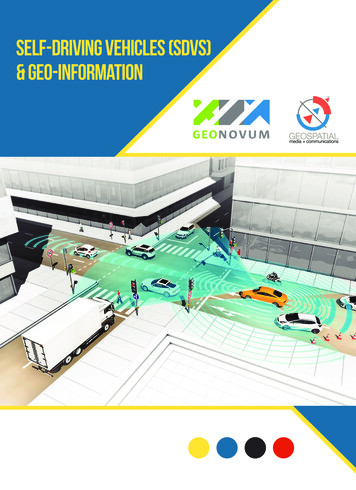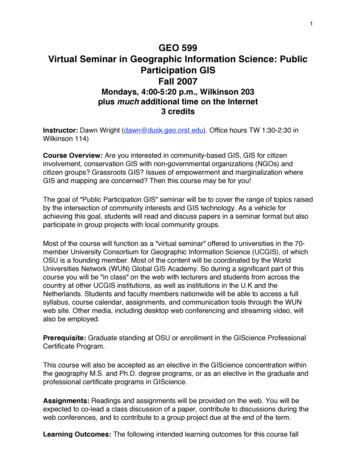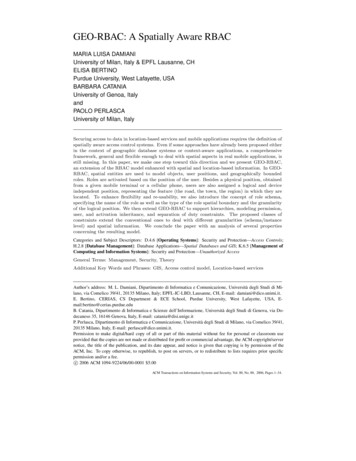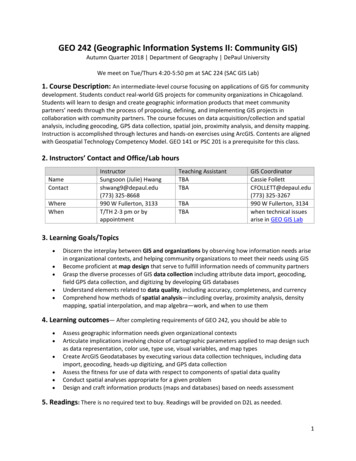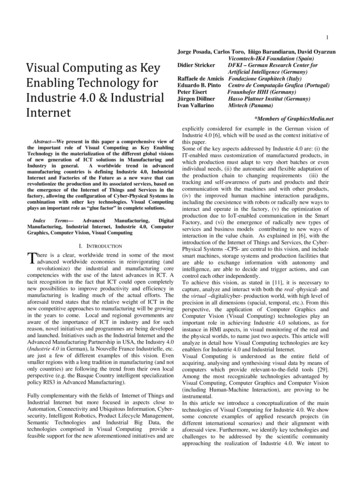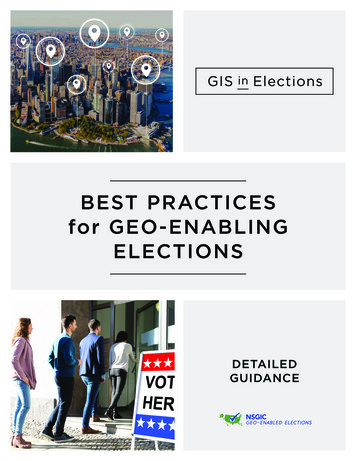
Transcription
BEST PRACTICESfor GEO-ENABLINGELECTIONSDETAILEDGUIDANCE
inWHY GISELECTIONS?Does America’s electoral systemknow where each voter resides?By and large, yes. But not nearlywell enough to correctly placeevery voter in the right votingdistrict and avoid election errors.When voters are given the wrong ballot,results are contested. Controversy, legalbattles, and even costly do-overs, follow.Using geographic information systems (GIS)to “pin” the location of each voter residenceon a map makes sense in the same way thatwe use our smartphones to navigate to anunfamiliar location: it enhances accuracy andcreates efficiencies. The risk of election errorsis reduced, data becomes easier to qualitycontrol, and voters can more easily verify thatthey have been included in the right district ordistricts.When we integrate GIS in elections,we strengthen our electoral system byincreasing its accuracy and reliability.Ultimately, we increase voters’ confidencethat their voices are being heard.With a presidential election on the horizon,and a redistricting process following shortlyon its heels, there has never been a moreimportant time to be able to correctly placevoters in the right voting district.NSGIC’SGEO-ENABLEDELECTIONSPROJECTUsing GIS in elections increaseselection accuracy and efficiency.Many states already use GIS for othermatters, including emergency responsesystems, infrastructure management,and zoning. Often, they have geographicinformation officers (GIOs) on staff.However, few states across our nationhave fully geo-enabled their elections.NSGIC partnered with states andsubject matter experts to develop fivebest practices for implementing GISin elections, a summary of which ispresented here.NSGIC (pronounced NISS-gyck), or theNational States Geographic InformationCouncil, is a state-led organization fordeveloping, exchanging, and endorsinggeospatial technology and policy bestpractices. Its Geo-Enabled Electionsproject focuses specifically on the use ofgeospatial information in elections.
BEST PRACTICESfor IMPLEMENTINGGIS IN ELECTIONSFor all the rewards from making the transition,implementing GIS into elections management requiresa sound plan, effort, and resolve.Technically, realizing the inherent visualizationand analytical advantages of GIS involvesreplacing non-spatial ‘address file’ systemswith election precinct and voter location datain a GIS format. In practice, this will requiresome additional investment and technology.It will require a lasting commitment fromelection leaders and staff training.And, it may require collaboration acrossagencies, changes to policy, and possiblysupporting statutory changes.LEARN MOREFind additional information atelections.nsgic.orgFollowing is a set of best practices to guide aGIS transformation, drawn from the insights,experiences, and counsel from ten states whoparticipated in NSGIC’s Geo-Enabled Electionsproject 2017-2019.“Leveraging GIS in our electoral systemincreases accuracy and efficiency inelections. It ensures every voter hasa chance to vote in the right electoralcontests. It also makes electionmanagement systems easier to updateas our physical environment changesthrough new development, or after theredrawing of boundaries, as occursthrough redistricting.”Molly Schar, NSGIC Executive DirectorR I G H T B A L LOT TO R I G H T VOT E R
BEST PRACTICES for GEO-ENABLING ELECTIONSCONVENE A TEAMOF SPECIALISTSSUMMARYGeo-enabling elections requirescollaboration at a high level betweenleaders in elections, informationtechnology and database administration,and geospatial information technology.Working together under the leadership ofan engaged project champion, officials, andkey staff should address critical elements ofgeo-enabling the elections process: projectgoals, requirements, timelines, budget, andgovernance. Including the GIS coordinatoror coordination office responsible forcoordinating GIS resources andimplementation from the outset is highlyrecommended.DETAILSLeaders must identify key stakeholders —officials with an interest or concern in electiontransparency, accuracy, and the use of technologyto improve election systems. Once the keystakeholders are identified, exploration andkick-off meetings must be held to answercrucial questions: Why are we making this change?; What are the opportunities for savingtime and money?; How will the new path improve thequality of the situation and process?an elections and a GIS perspective. Successfulchampions should plan to undertake the followingresponsibilities: Ensure the ultimate success of theproject; Identify and implement the project’sstrategic objectives; Invite essential leaders and expertise tothe project; Set expectations for committee workand include partners needed for thatwork; and Create a policy and technical committeeand designate chairs for both, as well asa lead staffer to support each.The policy committee should include thesecretary of state; chairs of relevant legislativestanding committees (government operations orthe equivalent) or designated members; chairsof the redistricting committee (if active); thestate elections director; and major political partydesignees.The technical committee should include theelections director; lead state elections IT supportstaff; county election officers (clerks); countyIT staff members from urban, midsize, and ruralcounties; the state GIO or GIS office manager;other relevant functional leads such as arepresentative from the DMV, 9-1-1, and the statetax commission; and appropriate private sectorexperts.These committees are important, andeach will bring a set of expertise andknowledge to the table to advance thestrategy of the entire team.Building consensus within the stakeholder groupis essential. This group should craft a unifiedmessage to move the work forward, identifying anappropriate timeline for proper implementation.Geo-enabled elections require champions thatcan promote the desired change from both4
BEST PRACTICES for GEO-ENABLING ELECTIONSPOLICY CONSIDERATIONSA funding strategy should be agreed uponincluding a detailed project budget and timeline.The policy committee should also focus ondrafting supporting legislation or administrativerules that promote: Data access, consistency, and flexiblebut useful data content guidelines; Data maintenance and an updatingschedule or improvement plan; Access to technical support andassistance; and Core election dataset sharing andimprovement (address points, votingunit boundaries, and other contextualdata aiding in the development andimprovement of the core electiondatasets like imagery, roads, addresses,and other boundaries).Third, the policy committee should carefullyevaluate potential legislation to best position andsupport a geo-enabled elections implementation,considering the following priorities:1. Developing legislation to codify the creationand updating of digital voting unit boundariesincluding language on how and when boundariesare shared into the statewide dataset. Thefollowing should also be considered:2. Identifying or creating a state address databaseand/or a geocoding service. The following shouldalso be considered:a. What is the frequency of updating the addressdatabase?b. Who will design/procure and administer thegeocoding service?c. How should these items be acquired, locallysourced, or commercially purchased? Ensure thattime is given to research the best options foryour state.3. Identifying how and when to report civicboundary changes. Civic boundary changesinclude the creation of new municipalities,annexations, de-annexations, and the dissolutionof municipalities, as well as changes in districtboundaries such as school districts. In addition toidentifying how and when to report, it is importantto determine who collects, certifies, and publishesthis data in the agreed-upon GIS format.4. Creating an official repository for geographicinformation data where the data is either createdby the state agencies themselves or is reportedby the local government up to state agencies.Understanding that transparency and data sharingis essential especially when the data needs forelections are so similar to that used by emergencymanagement, the US Postal Service, and theassessor’s office, special consideration should begiven to the possibility of statutory or regulatoryrequirements for sharing geospatial data assetsacross all state agencies and entities.a. Who is responsible for data submission, intake,and aggregation?b. How will the data be made accessible toothers?c. Who is responsible for the maintenance andadministration of the data archive or history?CONVENE A TEAM OF SPECIALISTS 5
BEST PRACTICES for GEO-ENABLING ELECTIONSTECHNICAL CONSIDERATIONSThe technical considerations will be focused on thespecifics of the platform, software, and data, andthe proper implementation of these pieces to fitthe needs of the state and project.The committee will lead the effort to developand recommend an implementation plan, asoftware assessment, a schedule for upgrades andenhancements, and also a transition plan. Statesshould be flexible in their implementation goals,certainly aiming for an all-at-once implementation,but also realizing a phased implementation withpilot areas may be the best way to move forward.The implementation plan will identify addressdata sources and data quality goals, the processfor determining the location of addresses, aschedule to ensure the proper precision of votingunit boundaries and their updates, techniquesfor keeping history of address records, toolsto implement address standardization, and thedetermination of assigned coordinates for anaddress that includes recording the method ofassignment.State implementations may differ dramaticallyfrom one another. These processes include howto allow, track, and review manual assignment ofgeographic coordinates or how to ensure that allvoters with the same address get assigned thesame coordinates. States should leverage otherstates’ experiences.Each state’s project team composition may alsobe different. In Utah, the Lieutenant Governor’soffice, the Automated Geographic ReferenceCenter (AGRC), the Department of TechnologyServices, and county elections and GIS staffwere instrumental in the effort. Justin Lee, StateElection Director of Utah, shared in the Utah casestudy how essential it is for groups like this to beable to work together. Likewise, in Washington,undertaking the Elections ModernizationProject required assembling an exploratorygroup comprised of IT professionals, electionadministrators, and county auditors, and accordingto Washington Election Director Lori Augino,collaborating with the State of Washington’sGeospatial Program Office was essential.elections.nsgic.orgCONVENE A TEAM OF SPECIALISTS 6
BEST PRACTICES for GEO-ENABLING ELECTIONSCOLLECT & SUSTAINA STATEWIDE VOTINGUNIT GIS LAYERSUMMARYTo geo-enable elections, a GIS layerdepicting voting unit boundaries is needed,and this must include both precincttabulation areas, as well as the minor ballotarea boundary divisions (also known as‘splits’ and ‘subs’). A sustainable approachfor updating this data — congruent with allelections-related deadlines and events, isessential.A simple data content specificationsdocument should be developed andadopted in coordination with electionoffices, including spatial data validationrules and processes to ensure dataintegrity.It is recommended that the developmentof an application programming interface(API) should be considered for both singleand bulk point-in-polygon GIS querycapabilities. The API-based spatial querywill enable automated determination andvalidation of voter assignments to votingunits.Finally, for transparency, an interactive webmap should be created for stakeholdersand the public to view the most currentvoting unit data.DETAILSAfter the census redistricting period, thesubsequent redistricting process, at state andlocal government levels, is the most importantcomponent in determining GIS statewide votingunit boundaries. Each state will have its ownprocess for how redistricting is determined, butonce that process is complete, the public entitythat has statutory authority to create and modifyvoting unit boundaries (usually the county-levellegislative branch — commission or council)should also be the steward of the GIS voting unitboundary files. Ideally, that data can be providedto the state repository in a GIS form, but it mayneed to be converted or created from non-GISsources like paper maps or digital PDFs.At a minimum, statewide voting unitboundaries must incorporate all boundarylines from state-level election districts(congress, state legislatures, state schoolboard, etc.).Ideally, they also incorporate boundary linesfrom significant local government electiondistricts (county commission, city council, majorlocal service districts, etc.) as well. Additionalminor boundaries, such as water, library, sewer,or cemetery districts may also be incorporatedinto voting unit boundaries for cases where therepresentation for these entities is elected as partof the general election. However, these minordivisions may necessitate the splitting of precinctboundaries into smaller voting unit boundariesknown as splits or sub-precincts.Ultimately, the smallest possible ballot areageographies should be assigned a unique identifierthat creates a one-to-one match with votingunit identifiers used elsewhere in the electionmanagement system. If possible, this uniqueidentifier should have some implied meaning,like a city name or abbreviation combined with anumeric voting unit number within the specifiedarea.7
BEST PRACTICES for GEO-ENABLING ELECTIONSThese unique identifiers should include commonlyconsumed identifiers (i.e. FIPS Codes) andcould incorporate the Open Civic Data DivisionIdentifiers (OCD-IDs). OCD-IDs are a commonidentifier of geopolitical divisions that are used bya variety of civic and technology entities. OCDIDs do not describe the geographic boundarybut provide
a sound plan, effort, and resolve. Find additional information at elections.nsgic.org LEARN MORE BEST PRACTICES for IMPLEMENTING GIS IN ELECTIONS “Leveraging GIS in our electoral system increases accuracy and efficiency in elections. It ensures every voter has a chance to vote in the right electoral contests. It also makes election




